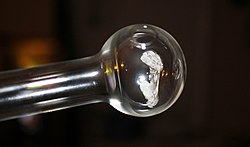Methamphetamine pipe
A methamphetamine pipe is a glass pipe which consists of a tube connected to a spherical bulb with a small opening on top designed for smoking methamphetamine. A pipe that has been used will have carbon deposit on the exterior of the bulb and white or gray crystal residues on the inner surface. [1] Alternate names include pizzo, [2] tooter [3] pilo, horn, oil burner, bubble, tweak pipe, meth pipe, gack pipe, crank pipe, crack pipe, pookie pipe, chicken bone, or ice pipe.

They can also ostensibly be used for legal purposes, including applying the hole "on the top of an eucalyptus bottle" for inhaling aromas or moisture. [4] [5] However, there is a lack of evidence that such devices are used in this manner by ordinary individuals. Many articles of drug paraphernalia are sold under intentionally misleading names and product descriptions to skirt regulation and to refer to their function euphemistically.
These pipes are often sold at head shops and convenience stores. [6]
Pizzos are often advertised as "oil burners" or "mystic vases" designed for burning incense oils. Wish has listed the glass item as a "Colored Glass Oil Burner Pipe" [7] and received criticism from the Queensland government as the region struggled to battle the rising use of methamphetamine. [8]


